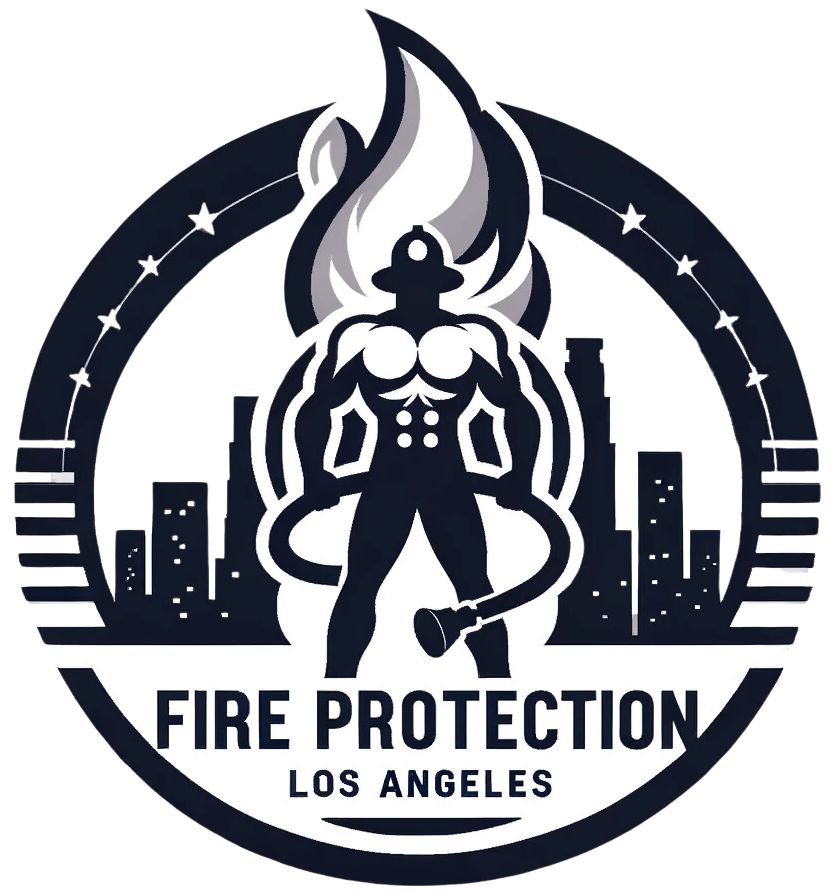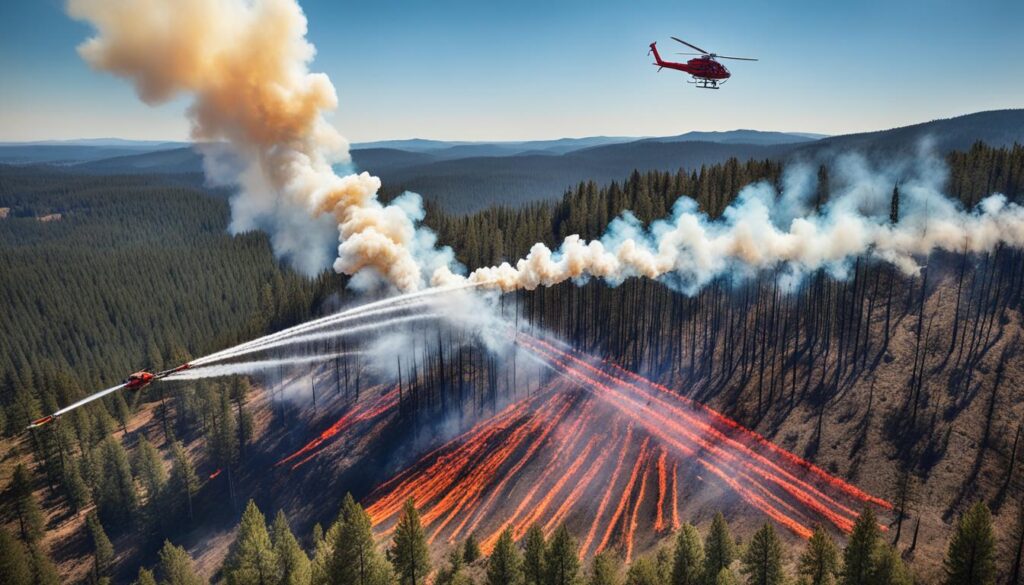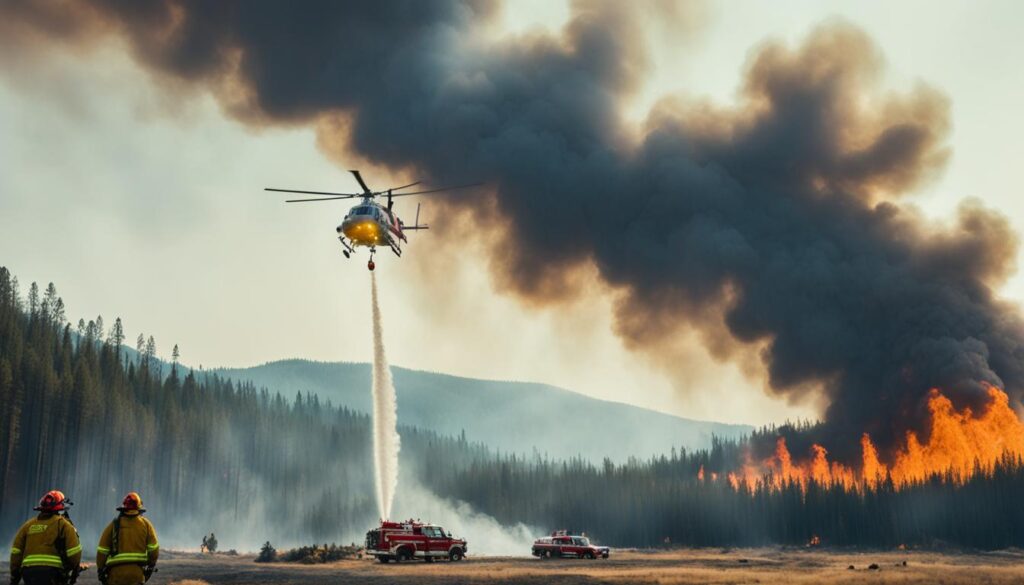In the United States, a staggering 10 million acres were consumed by wildfires in 2020, demonstrating both the fierce power of uncontrolled flames and the critical importance of effective fire suppression tactics. Such statistics underscore the relentless battle faced by fire management teams and highlight the ever-evolving complexities within the realm of forest fire prevention methods. This eye-opening figure serves as a stern reminder of the scale at which wildfire control strategies must operate to protect ecosystems, property, and human lives.
The scope of fire management techniques extends beyond the mere dousing of flames; it encapsulates a comprehensive overview of forest fire suppression strategies that include preventive maintenance, innovative suppression technology, and the enhancement of ecological resilience. In exploring the intricacies of forest fire suppression, one must delve into the rich history, complex policies, and multifaceted approaches that define today’s wildfire control strategies.
From early 20th-century efforts to extinguish every incipient fire to current practices that balance suppression with ecological consideration, we begin our journey toward understanding the full spectrum of forest fire suppression. Adapting to the changing landscape of wildland fires calls for a delicate blend of experience, knowledge, and adaptability – qualities that are vital in shaping the future of wildfire mitigation and ecosystem management.
The Evolution and Impact of Fire Suppression Policies
The interplay between natural wildfire occurrences and human interventions has long been a subject of considerable debate and policy evolution. As our understanding of wildfire dynamics grows, so does the complexity of strategies employed to manage and mitigate forest fires. The turn of the 20th century marked a definitive shift towards aggressive suppression techniques, deeply influencing both the natural landscapes and public consciousness with regard to wildfire management.
Historical Perspective on Forest Fire Suppression
Fire suppression within the United States traces its genesis to early conservationist thought, particularly the need to protect valuable timber resources. Major fire events, such as the devastating Peshtigo Fire in 1871, catalyzed a movement against wildfires, birthing a culture of prevention and control. The 1905 founding of the U.S. Forest Service and the sweeping fires of 1910 solidified a national ethos of total fire elimination—an ethos symbolized by figures such as Smokey Bear and slogans exhorting the public to prevent forest fires.
Changes in Fire Suppression Over the 20th Century
Initially, the model for fire suppression was simplistic: extinguish all fires. However, as the century progressed, it became clear that this approach had limitations. The introduction of wildfire suppression equipment and suppression techniques for forest fires gradually diversified the methods available to firefighters. Yet, a strict adherence to suppression led to an accumulation of fuels in many ecosystems, a condition that paradoxically set the stage for eventual larger and more destructive fires.
Ecosystem Consequences of Fire Suppression
The ecological impacts of an aggressive fire suppression policy have been profound. By intervening in the natural fire cycle, efforts at entirely preventing wildfires have sometimes altered species composition, disrupted habitats, and contributed to increased outbreaks of insects and diseases. This shift in ecosystem balance has prompted the need for diversified wildfire mitigation strategies aimed at restoring natural fire regimes and reducing the occurrence of catastrophic blazes.
Public Perception and Fire Management Decisions
The Yellowstone fires of 1988 were a pivotal moment for public perception. They underscored the complex relationship between wildfire management policies and ecological health, influencing societal views on controlled burns and natural fire acceptance. Subsequently, greater emphasis on community involvement and education has led to an increased appreciation for the role of fire in maintaining healthy forest ecosystems. However, the challenge remains to align effective wildfire strategies with community safety and ecological sustainability.
| Decade | Policy Focus | Notable Events | Technological Advancements |
|---|---|---|---|
| Early 1900s | Fire Suppression | 1910 – The Big Burn | Introduction of Fire Lookout Towers |
| Mid-1900s | Fire Prevention Campaigns | 1944 – Smokey Bear Campaign | Development of Air Tankers |
| Late 1900s | Integrated Fire Management | 1988 – Yellowstone Fires | Use of Satellite Imagery in Fire Detection |
| 21st Century | Mitigation and Ecological Restoration | Ongoing – Wildland-Urban Interface Issues | Advancements in Wildfire Modeling Software |
Modern Forest Fire Suppression Techniques and Strategies
The advancement of effective fire suppression tactics has been a cornerstone in the dynamic approach to modern fire management tactics. The amalgamation of data-driven models and scientific understanding has given rise to strategic and adaptive methods designed to combat ever-evolving fire scenarios. As residential expansion encroaches upon wildland-urban interfaces, the necessity for innovative suppression techniques escalates, pushing the boundaries of traditional firefighting practices.
Key to the progression in forest fire suppression is the integration of technological advancements with on-the-ground methodologies. Airborne resources, such as aerial water drops and retardant delivery, complement the exhaustive efforts of ground crews. While the deployment of smokejumpers—highly trained firefighters who parachute into remote areas—ensures rapid initial attack capabilities in inaccessible regions.
With more sophisticated approaches to fire suppression, we witness a delicate balance between controlling burn severity and nurturing the ecological role of fire within forest ecosystems.
Smoke management techniques have also seen substantial development, both in terms of forecasting and operational execution. Controlled burning and the strategic use of barriers have become fundamental in efforts to safeguard communities while preserving air quality.
- **Refined Predictive Models:** establishment of real-time tracking systems to monitor fire spread and intensity.
- **Comprehensive Training:** persistent education of fire management personnel on the ecology of fire and the intricacies of modern suppression methods.
- **Community Engagement:** increased involvement of local populations in fire preparedness and mitigation strategies to reduce the impact of wildfires on human settlements.
| Suppression Tactics | Benefits | Considerations |
|---|---|---|
| Aerial Support | Quick delivery of suppressants over large areas; access to remote locations. | Dependent on weather conditions; high operational costs. |
| Controlled Burns | Reduces fuel loads; restores natural fire regimes. | Requires meticulous planning; potential for escape. |
| Smokejumpers | Rapid initial attack; specialized response in harsh terrain. | Physically demanding; limited number of deployable units. |
In the ongoing effort to mitigate wildfire damage, the future of fire suppression is likely to witness greater emphasis on preemptive action, with the common goal of sustaining the many benefits that fires naturally provide to the environment while protecting human life and habitat.
Conclusion
As we delve deeper into the overview of forest fire suppression, it’s clear that the recurring theme is one of adaptation and resilience in the face of nature’s challenges. Today’s forest fire management techniques are tasked with not only quelling the immediate dangers but also ensuring the future sustainability of our ecosystems. With each blaze, our understanding of forest fire prevention methods advances, feeding into a cycle of continuous improvement in wildfire control strategies.
Challenges Facing Today’s Fire Suppression Efforts
Contemporary society is witnessing an uptick in both the frequency and intensity of forest fires. Effective fire suppression tactics are now more crucial than ever. However, one primary hurdle remains the increasingly complex wildfire-urban interface. This nexus is where human settlements and fire-prone forests meet, demanding an unprecedented level of finesse and agility in firefighting efforts. Faced with a developing landscape and shifting environmental factors, fire suppression resources are stretched thinner, propelling us toward innovative solutions and strategic collaboration.
The Future of Forest Fire Management and Prevention
Looking ahead, the trajectory of forest fire management is poised to embrace a more holistic perspective. Prevention remains paramount, with proactive land management activities gaining emphasis to reduce the need for reactive suppression. The future beckons a harmonious integration of technology, ecology, and societal needs to foster environments where natural fire regimes are not just a destructive force to be battled but a phenomenon to be understood and utilized for long-term ecological health.
Striking a Balance: Conservation and Fire Management Coexistence
This delicate interplay between conservation and fire management underlines the essence of sustainable forest management. To strike a balance, a robust commitment to science-led research and public education is indispensable. Through comprehensive fire management techniques, we aim for a congruent existence with our natural environments, recognizing fire as an essential ecological process. This equilibrium ensures that while we protect communities and critical habitats, we also preserve the inherent regenerative power of wildfire within forest ecosystems.










